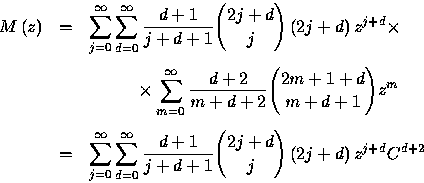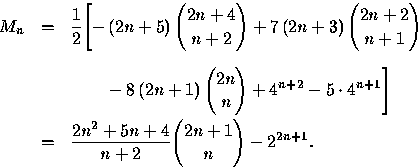 |
Journal of Integer Sequences, Vol. 2 (1999), Article 99.1.5 |
 |
Journal of Integer Sequences, Vol. 2 (1999), Article 99.1.5 |
Lou Shapiro
Math Dept.
Howard University
Washington, DC 20059
Email address: lws@scs.howard.edu
Abstract: In the "tennis ball" problem we are given successive pairs of balls numbered (1,2), (3,4),... At each stage we throw one ball out of the window. After n stages some set of n balls is on the lawn. We find a generating function and a closed formula for the sequence 3,23,131,664,3166,14545,65187,287060,1247690,..., the n-th term of which gives the sum over all possible arrangements of the total of the numbers on the balls on the lawn. The problem has connections with "bicolored Motzkin paths" and the ballot problem.
We will find both a generating function and a closed formula for this sequence. First we return to the first question and transform it to a question about paths.
Such paths are called bicolored Motzkin paths (see [5]). If there had been only one kind of level step and the paths ended on the x-axis we would have regular Motzkin paths (see [1],[3], or [7] for more information on Motzkin paths and Motzkin numbers).
Let ![]() be the number of possible paths that end at
be the number of possible paths that end at
![]() . Here is a table of small values
. Here is a table of small values

We can make three observations. One is that with the four kinds of steps we get the recursion
![]()
Secondly we have

Thirdly ![]() the
the ![]() Catalan number
(see [6] and [7] for different proofs).
Catalan number
(see [6] and [7] for different proofs).
Now we return to the balls on the lawn after ![]() turns. Let us look at
a
typical example after 6 turns.
turns. Let us look at
a
typical example after 6 turns.
![]()
We now want to shift back to subdiagonal paths from ![]() to
to ![]() using unit east and north steps. If we number
the
steps along each such path starting at the origin using the numbers
to 2n+1, then the numbers of the horizontal steps correspond to the
numbers of
the balls on the lawn except that we ignore the initial horizontal step
numbered 0. All subdiagonal paths must go from
using unit east and north steps. If we number
the
steps along each such path starting at the origin using the numbers
to 2n+1, then the numbers of the horizontal steps correspond to the
numbers of
the balls on the lawn except that we ignore the initial horizontal step
numbered 0. All subdiagonal paths must go from ![]() to
to
![]() at the first step so let us look on
at the first step so let us look on ![]() as our starting point and
as our starting point and ![]() as the terminal point.
We
then look at steps in pairs to set up a correspondence with bicolored
Motzkin paths
as the terminal point.
We
then look at steps in pairs to set up a correspondence with bicolored
Motzkin paths

To evaluate the sum over all possible sets of balls on the lawn takes a bit more doing and its worthwhile to separate out some definitions and lemmas first.
The following lemmas can be proved combinatorially but instead we refer
to
Concrete Mathematics [4], page 203, formulas ![]() and
and ![]() for the first two lemmas and leave the others as
exercises.
for the first two lemmas and leave the others as
exercises.
Lemma 1

Lemma 2

Lemma 3

Lemma 4
![]()
Lemma 5
![]()
Lemma 6

Lemma 7
The number of subdiagonal paths from ![]() to
to ![]() will be denoted
will be denoted ![]() and
and

We now want to embark on the main computation. Note first that

Before launching into the evaluation lets look at each term. There are
![]() paths from
paths from ![]() to
to ![]() and
and ![]() paths from
paths from ![]() to
to
![]() .What does it mean for a path to have arrived at
.What does it mean for a path to have arrived at
![]() ?
Of the balls
?
Of the balls ![]() , i-1
of them are on the lawn and j of them are to stay in the room.
The horizontal
step
, i-1
of them are on the lawn and j of them are to stay in the room.
The horizontal
step ![]() indicates that
ball number i+j is to be on the lawn and hence the term
indicates that
ball number i+j is to be on the lawn and hence the term ![]() .By Lemma 7 we then get
.By Lemma 7 we then get

We want to find a closed form for the generating function








![]()

![]()
![]()
The first and third of these remarks can be shown by routine algebraic manipulations and the second follows from the first as follows:
![\begin{displaymath}
\begin{array}
{rcl}
zC^{3}B^{3}\left( 1+\displaystyle\frac{2...
...B^{3}+\frac{1}{z^{2}}B^{2}-5\frac{B^{2}}{z}\right] .\end{array}\end{displaymath}](img65.gif)

Two other remarks can be made here. First, an asymptotic result,
![]()
Problem 19(s) of reference [7] is succinct but less colorful.
It asks one to show that the Catalan numbers count sequences of positive
integers such that ![]() and
and ![]() .The
references there point out a connection with an indexing of the weights
of
the
.The
references there point out a connection with an indexing of the weights
of
the ![]() fundamental representation of the symplectic
group
fundamental representation of the symplectic
group ![]() .
.
The problem was brought to our attention by Ralph Grimaldi, see [6], who refers to the logic text [8] where it is pointed out that after an infinite number of turns the balls remaining in the room can be either the empty set, a finite set of arbitrary size or even an infinite set such as all the even numbered balls.
Received July 17, 1998; revised version received Jan 13, 1999. Published in Journal of Integer Sequences March 15, 1999.